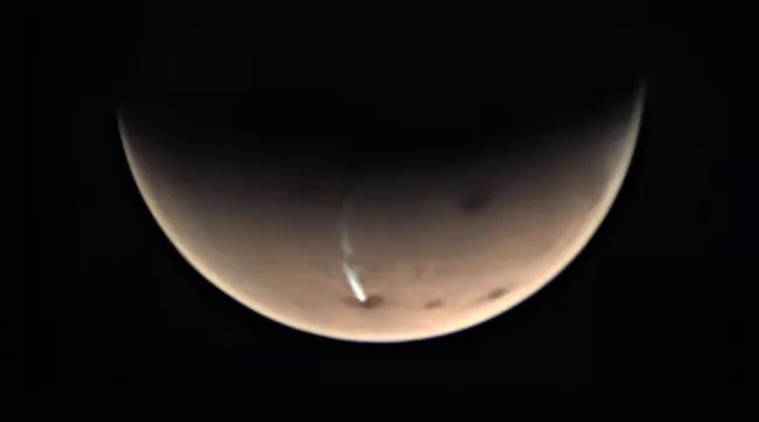Due to the cloud’s tendency to fade, scientists find it hard to study. However, Mars Express’ Visual Monitoring camera makes it possible to get a photograph of the planet in a single frame instead of a combination of photos strung together.
A weird-looking, extremely elongated white cloud is back as it has been spotted after almost two years over an extinct Martian volcano, Arsia Mons which is located just a bit south of the Martian equator. The scientists were waiting for this rather periodical event with European Space Agency’s (ESA) Mars Express orbiter.
The scientists have named it the cloud as Arsia Mons Elongated Cloud (AMEC). As per ESA, the tail-like cloud made of water ice can be as long as 1,800 km. It is formed when local winds interact with the topography in a certain way and not because of the volcano it forms over.
“We have been investigating this intriguing phenomenon and were expecting to see such a cloud form around now,” Jorge Hernandez-Bernal, a PhD candidate at the University of the Basque Country in Spain and the lead author of the ongoing study, said in a statement released by the ESA, which runs the spacecraft.
“This elongated cloud forms every Martian year during this season around the southern solstice, and repeats for 80 days or even more,” Hernandez-Bernal said. “However, we don’t know yet if the clouds are always quite this impressive.”
The fascinating phenomenon doesn’t just disappear all of a sudden but gradually fades in a few hours in the morning only to return the next day. Due to the cloud’s tendency to fade, scientists find it hard to study. However, Mars Express’ Visual Monitoring camera makes it possible to get a photograph of the planet in a single frame instead of a combination of photos strung together. This is possible because Mars Express spacecraft has a highly elliptical which helps it get a wide field of view.
Scientists aim to study AMEC’s forming patterns and its history. Currently, according to the two appearances of the bizarre-looking clouds, the scientists know that it forms over Mars’ when the days are shortest in the Northern hemisphere and shortest in the Southern hemisphere.













![Hotstar Premium Cookies 2019 [*100% Working & Daily Updated*] Hotstar Premium Cookies 2019 [*100% Working & Daily Updated*]](https://tahav.com/wp-content/uploads/2019/11/Hotstar-Premium-Cookies-Free-100x70.jpg)



